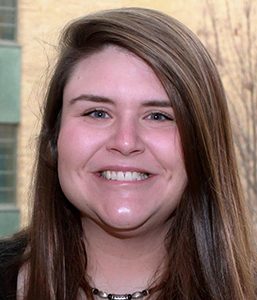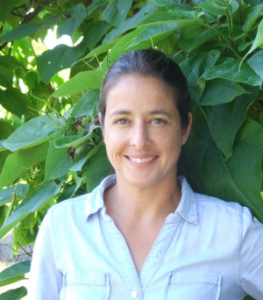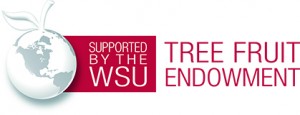Written by B. Sallato, A. Thompson, S. Harper, updated Nov, 2022
The Little Cherry Disease epidemic in Washington and Oregon is largely attributed to the X-disease phytoplasma (XDP). Currently, there is no known treatment for XDP-infected trees; instead, orchardists must control the spread of the disease through prompt tree removal. Opportune management of XDP-infected trees involves testing neighboring trees and removing infected trees. The decision of replanting ground with sweet cherry trees poses several questions regarding best practices. Regardless of induvial of whole block removal, growers have different strategies; applying an herbicide to the tree trunk, one or more targeted root removal, soil ripping, fumigating, and/ or following the soils. Despite these measures, orchardists have reported new XDP infections in newly planted blocks, leading to the following questions:
1. Do infections in young orchards arise from roots that have survived in the soil, infected trees from the nursery, or leafhoppers moving between orchard blocks?
2. How relevant are the remaining infected roots in the spread of the disease in my newly planted block?
3. What should I do to manage the risk of re-infection of new orchards?
To answer these questions, OSU and WSU Faculty and Extension are evaluating removal and replant strategies for X-disease infected orchards by 1. evaluating the survival of roots in the soil under three common replant strategies, and 2. evaluating the rate of infection of replanted trees under common replant strategies
Methods
Orchards with different removal and replanting strategies were selected in WA and OR. Table 1. On each site, initial soil analysis and excavation were carried out to identify the presence of live roots. When present, roots were tested for XDP. Given that the objective of this project was to determine the risk of soil and or remaining roots as a source of infection, we needed to isolate the risk of transmission via leafhoppers and or nursery stock. For this purpose, in 2021, 10 trees were initially tested for LCD pathogens to ensure trees selected for this project were free of viruses and XDP at planting. Three out of 60 trees sampled were positive to XDP (one on three different orchards), and immediately removed by the grower. The non-positive trees were selected for this project.
Table 1. Removal and replanting conditions sites selected in WA and OR.
| Location – Cultivar/Rootstock (previous rootstock) | Herbicide/Tree cut | Removal/Soil | Fumigation | Period to replant |
| WA 1*
Skeena/Gi.12 (G.12) |
August – Stump herbicide | Spring – Stump removal. Replace the soil in the planting hole | NO fumigation | Next spring |
| WA 2 Suite note/Gi.12 (Mazzard) | August – Stump herbicide | Winter – excavator | Fall Fumigation | One Year Fallow |
| WA 4
Chelan/Mazzard 1 |
August – Stump herbicide | Fall – excavator | Spring Fumiation 1rate | One year fallow
|
| WA 5
Chelan/Mazzard 2 |
August – Stump herbicide | Fall – excavator | Spring Fumigation x2 rate | One year fallow |
| WA 3
Chelan/Gi.12 (Cherry) |
No herbicide | Fall – excavator | Spring Fumigation | Next Spring |
| WA 7
Chelan/Gi.12 (Peach) |
No herbicide | Fall – excavator | Spring Fumigation | One Year Fallow |
| WA 6
Coral/Mazzard (K5) |
No herbicide | Fall – excavator | Spring Fumigation | Next Spring |
| WA 8
Skeena/Gi.12 (G.12) |
No herbicide | Summer remove large | NO fumigation | Same Fall |
| The Dalles 1
(Mazzard) |
Stump herbicide | Fall – Ripping and large root removal | Cover cropping | Undecided |
| The Dalles 2*
Bing/K.6 (Mazzard) |
August – Stump Herbicide | Fall – Large Root Removal | NO fumigation | Following spring |
| The Dalles 3
Benton/K.6 Mazzard |
August – Stump Herbicide | Fall – Excavator. Ripped. | NO fumigation | Three years fallow |
| The Dalles 4
Suite Note/K.6 (Mazzard) |
Herbicide applied to root suckers for two years. | Fall – excavator. Removed large roots. RIpped. | NO fumigation | Two years fallow |
* Individual tree removal in a block with high pressure and confirmed X-phytoplasma.
Ten 10 trees were netted (N) and 10 trees were selected as un-netted controls (C). Having unnetted controls could provide insights of the risk of leafhopper infection versus netted trees. The shade net installed in all sites is a 7-8% shade bee netting from OVS, with a mesh size of 6.8 mm x 1.6 mm. Nettings were installed during spring around each tree or covering entire trees depending on the size of the orchard and system (Figure 1). To monitor the effectiveness of the netting in preventing leafhopper access, each cage had one or more yellow sticky traps. When trees were not fully caged (e.g middle picture in figure 1) we place sticky traps at the base of the tree and in the top of the trees. Orchards were monitored throughout the season.
In 2022, the second year, the same trees were sampled twice for XDP and LChV, on July 7th and September 25th, collecting spurs and leaves (as these are none bearing trees there was no fruit). For research purposes, qPCR Ct values below 40 were considered positive for the pathogen. With Ct values above 35 (low titer), the infection likely occurred in the current year and trees are asymptomatic. With Ct values between 30 and 35, the infection likely occurred the previous year, and trees can still be asymptomatic. With Ct values below 30, the infection likely occurred two or more years prior to the testing, and symptoms can be present.
Figure 1. Examples of netting strategies depending on tree high and system, utilizing 8% shade net from OVS.
Results
Live infected roots were only found in WA 1, which corresponds to the only site of individual tree replanting. In all other sites, there were no live roots found, regardless of the removal method.
In 2022, XDP infection averaged 36% in WA sites, while in OR, one tree tested positive for XDP (Ct of 38.4). In July sampling, there were more XDP infected trees than in September sampling, with several cases in which a tree came back positive in July and the same tree was negative (or Ct values above 40) in September. For example:
• In WA 1 (individual tree replanting), three trees were positive to XDP in July with between Ct 30.8 – 36.5. In Sept, all three trees were negative to XDP.
• In WA 2, July sampling reported 80% and 40% XDP infection in the netted and control trees respectively (Ct > 32), however only one of those came back positive in September (Ct 39.5).
• WA 4 and W5, located in the same orchard, with different fumigation treatments. XDP incidence in July was 100% and 88% in September, regardless of the netting. Ct values in these sites ranged between 16.5 and 39. Lower Ct values (below 30) suggest trees were infected prior to planting in 2021. This orchard has no cover crop and intense weed management program, and there were no leafhoppers found in the yellow traps.
• WA 6, located near Benton, reported no XDP positive trees, however, two of the controls were positive to LChV2, with Ct values above 36.
• WA 3, three netted trees were XDP positive in July (Ct values above 39.4), while in September, another seven control trees came back positive.
• WA 7, two trees were positive to XDP in July (Ct above 37.5), and in Sept. only one of the two reported positive to XDP, plus two additional trees.
2022 findings
Given the findings from this second year of the project, we learned that early infection is not always detected by qPCR test, which could be associated with the pathogen distribution within the tree or low infection levels in tissue. According to ongoing research by Harper’s laboratory, there is a seasonal and spatial variation of XDP. For example, in 2022, the detection rate with qPCR dropped in September, compared with July, and leaf tissue has shown more variability and lower sensitivity to the test, compared with fruit and stems.
Thus, we cannot be certain that the initial negative trees in 2021 were not infected trees. Which prevents us to isolate the source of infection observed in this trial, regardless of the presence of netting.
It is also possible that our netting system failed to control leafhoppers, however, leafhoppers were not found in the yellow sticky traps inside the cages at any of the sites. In 2023 we will incorporate other trapping systems inside and outside the netting, to determine leafhopper pressure on these sites. Infection due to root grafting in the replanted sites seems unlikely, given that we didn’t find any XDP infected roots in the replanted sites, of significant diameter. However, should not be discarded and we will monitor root grafting in trees at the time of removal.
Questions and answers
Here we share additional questions we received after the Washington Tree Fruit Research Commission review and their answers.
1. What strategy growers should take with trees that report Ct values above 40, compared to those below 30?
Ct values in the mid to low 30s correlate with mild symptoms in individual clusters, ~25 or below is generally severe. Symptom severity is concentration-dependent. A high Ct/low phytoplasma concentration make take several seasons to become severe, but it will. Disregarding weak positives is a serious long-term risk.
2. What Ct values should we use as cut-offs for positive samples?
The designers of the assay (Kogej et al. 2020) state that a Ct of 40 or less is positive, and we (Harper lab) have been able to successfully confirm this using other XDP assays targeting different genes, our genotyping marker panel, and nested PCR/sequencing. They are not false positives. Disregarding a positive just because it’s weak is a serious long-term risk.
Cut-off values are arbitrary and used to compensate for inter-lab variations in technique and sample quality for the purposes of proficiency testing. Commercial labs used 37 or 38 as a cutoff value because, below that point, reproducibility between tissue samples taken from the same tree becomes a problem due to low titer, scattered distribution, and inhibitory compounds in the extraction. We suggest that where above 37 or 38 Ct values are found, and you really have doubts, the tree should be retested the next year.
3. Could temperature be causing the variation in detection?
Yes, we have found that extremes of cold temperatures and heat suppress phytoplasma concentration, particularly if the tree is stressed and growth patterns change.
4. What size of mesh was used for netting? Does a different size mesh need to be used?
The shade net utilized in all the sites is a 7-8% bee net from OVS. We did not find any leafhoppers inside the cages; however, further research needs to be conducted to learn about the best exclusion systems for leafhoppers.
5. How did the netted trees get infected?
Each site had a different scenario explained above. The infection of netted trees could’ve happened before installing the netting, but it was not detected due; a) low concentration levels in the sampled tissue, seasonal variability of the pathogen, and conditions (cold or heat) that suppressed the pathogen. Infection could also occur if the netting system failed during the season, for example, rips, openings, or leafhoppers crawling inside the cage. Although we monitored by weekly to prevent these conditions, they cannot be discarded. Ultimately, root grafting could happen in the sites’ where live infected roots were found, which is only in the site with individual tree replanting, thus seem unlikely.
6. Why do you think the test results were so different from July to September?
In 2022, September samples were too late and phytoplasma titer was dropping off statewide. Growers should be aware that the start and end dates of the testing window can shift by up to a month from year to year, depending on the weather.
We will continue evaluating these sites in 2023 to understand the progression of the disease, detection dynamics throughout the season, and expression of symptoms. Growers have provided us with valuable information regarding weed and leafhopper control, which will aid in the understanding of XDP development.
Contacts
Ashley Thompson
ashley.thompson@oregonstate.edu
Fruit Matters articles may only be republished with prior author permission © Washington State University. Reprint articles with permission must include: Originally published by Washington State Tree Fruit Extension Fruit Matters at treefruit.wsu.edu and a link to the original article.






